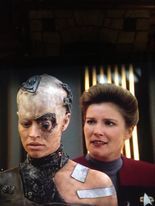Trauma
Where Too Many Have Gone Before: Trauma in "Voyager"
Star Trek Voyager presents an allegory of trauma in the story of Seven of Nine.
Posted July 23, 2022 Reviewed by Vanessa Lancaster
Key points
- While science fiction is known for commenting on contemporary society, Star Trek focuses equally on personal psychological issues.
- Borg assimilation, which consists of a violent assault that changes the victim, symbolizes trauma in the Star Trek series.
- Voyager shows that empathy and support are central to a therapeutic relationship and healing through the story of Seven of Nine.
In the middle of their long journey through the Delta Quadrant to get back to earth (ETA seventy years from start time), the starship Voyager encounters a species called the Borg. These aliens assimilate other species to acquire their knowledge and labor, injecting them with nanoprobes that take over their minds; later, they surgically replace organic material with manufactured parts to give their victims superior powers.
Assimilation resembles a rape or other kind of invasive bodily assault, but it applies metaphorically to all traumatic experiences that, by definition, impair our sense of safety and well-being. In scenes of assimilation, the victim often cowers as the relentless attacker advances; some resist, only to be eventually overcome as phallic tentacles emerge from the Borg attacker that penetrates the victim. The tag phrase of this species is “resistance is futile.”

Science fiction is known for allegorizing sociopolitical issues, but the Star Trek programs tend to focus just as intensively on psychology. Voyager and other Star Trek series featuring the Borg accurately represent various aspects of the psychology of trauma. For instance, the captain of the Enterprise, Jean Luc Picard, is haunted by his period of assimilation, and years later, in Picard, he has a flashback as he walks through an abandoned Borg vessel.
But Seven of Nine, Tertiary Adjunct of Unimatrix 01, presents the process not only of trauma but of healing. When Voyager narrowly escapes the Borg, they accidentally take her with them. But far from savoring her good fortune, Seven, as she comes to be called, does everything in her power to return. There are different names for this kind of attachment to an abuser: trauma bonding, Stockholm syndrome, capture bonding, and identification with the aggressor.
Supportive reflection, empathy, emotional availability, and consistency are crucial elements that enable recovery; these elements of healing form the heart of the therapeutic alliance, the strength of which predicts success across treatment modalities.
But they can be found in other relationships, as seen in Seven’s encounters with Captain Janeway. She is shaken to the core when she realizes she has been severed from the Borg Collective.
Janeway begins her therapeutic work by encouraging Seven to share her feelings: “I want to help you, but I need to understand what you’re going through.”
Seven rejects this invitation (“Do not try to engage us in superficial attempts at sympathy”). Still, Janeway persists by reflecting on Seven’s feelings: “It’s obvious that you’re in pain, that you’re frightened, that you feel isolated, alone. You were part of a vast consciousness...the security and strength of a unified will, and you’ve lost that."
Seven admits the accuracy of Janeway’s observations while still rejecting her help. But Janeway continues to offer support and a holding environment. To Seven’s objection, “I cannot function this way alone,” Janeway responds, You’re not alone. I am willing to help you.”

In good therapeutic fashion, Janeway tries to get Seven to reconnect with dissociated memories of her life as human, Annika Hansen; she was assimilated when she was six years old and can't remember that childhood (I have a teen client who suffers from complex PTSD and who cannot remember most of her childhood).
Janeway shows Seven a picture of Annika saying, “There’s still a lot we don’t know about her. Did she have siblings? Who were her friends? Where did she go to school? What was her favorite color?”
Seven continues to deny her human identity, the identity that separates her from the abuser to whom she is attached, accusing Janeway of “assimilation” for forcing her to own an identity she doesn't want: “You’re no better than the Borg.”
The rejoinder: I’m just giving you back what was stolen from you, the existence you were denied, the child who never had a chance. That life is yours to live now." Therapists can’t change the past, but we hope to repair the lives stolen from our traumatized clients by giving them a chance to attain the well-being, growth, and functionality that was stolen from them
Seven finally accepts that she must live with humans and begins to accept her human identity. After her surgical implants have been removed, Captain Janeway and the Doctor check in on Seven before she begins her regeneration cycle (she can’t sleep normally yet and needs to spend time in a Borg alcove each day). As they leave, we are left with an exchange demonstrating that Janeway has forged a bond.
Janeway (handing Seven communication badge): Good night. If you need anything, contact me.
Seven: Red
Janeway: What?
Seven: The child you spoke of, the girl, her favorite color was red.

Seven connects both to her past and Janeway. She has begun her journey of recovery, a journey home as important as Voyager's back to earth. Voyager lacks a ship’s counselor, but its captain fulfills that function by taking responsibility for the well-being of its crew. Counselor Troi couldn’t have done a better job.
References
Herman, J. L. (2015). Trauma and recovery: The aftermath of violence--from domestic abuse to political terror. Hachette. UK.
Baier, A. L., Kline, A. C., & Feeny, N. C. (2020). Therapeutic alliance as a mediator of change: A systematic review and evaluation of research. Clinical Psychology Review, 82, 101921.




